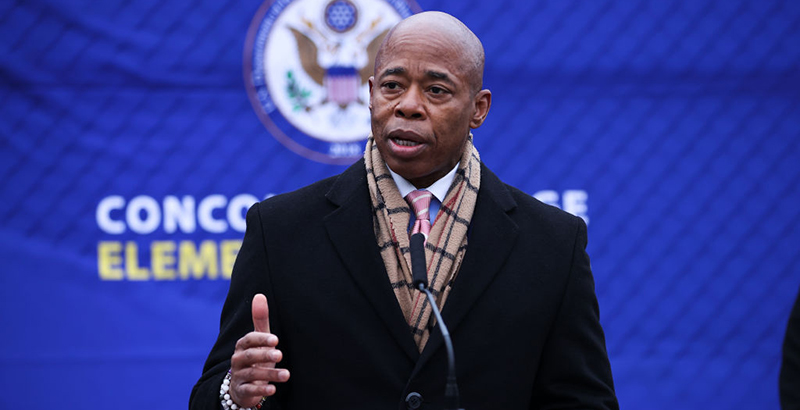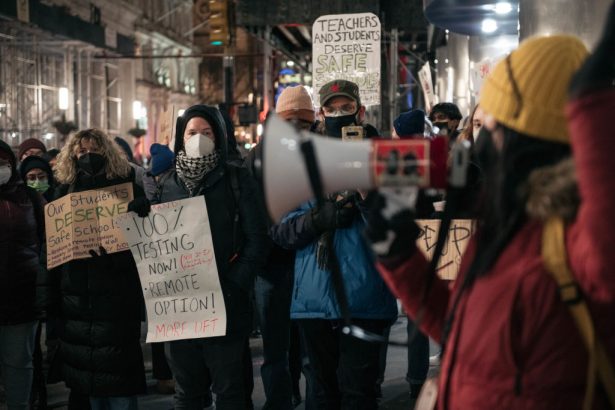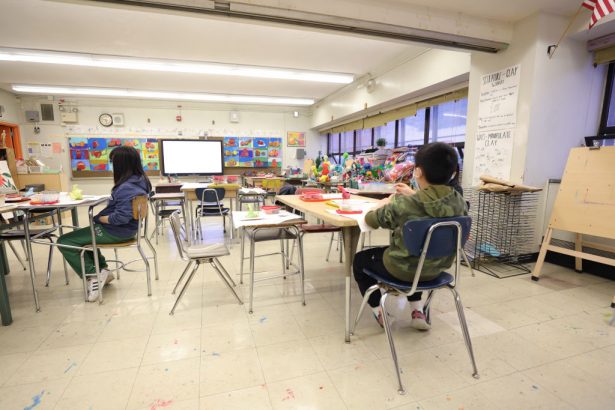Adams: No Remote Learning Option in NYC Schools for 6 Months

Get stories like this delivered straight to your inbox. Sign up for The 74 Newsletter
Updated
It will take roughly six months before New York City schools can add remote learning options, Mayor Eric Adams told elected officials Wednesday morning.
The timeline, which effectively means no virtual instruction through the end of the 2021-22 academic year, represents a stark rejection of the concerns of students, parents and teachers worried for the safety of in-person learning as the Omicron variant continues to cause roughly 40,000 new COVID cases per day in the city.
On Tuesday, thousands of students walked out of class, protesting what they said were unsafe conditions. In the first week of January, over two dozen city and state legislators signed a letter to Mayor Adams calling for a temporary pivot to remote learning through Jan. 18 to slow the spread of the virus.
Adams’s estimate that it will take about six months for city schools to include virtual options came during a call with officials responding to their request for a virtual option.
New York state Sen. Jabari Brisport was on the call and is one of the officials who co-signed the letter.
“At first, the talking point (from the mayor) was that they would get back to us later at a future meeting about the remote option,” Brisport told The 74. “Near the end, when pressed again on a remote option, the pushback was that he wanted to do it the correct way and have as many stakeholders involved as possible, and make sure it works the best for students and teachers and that that process will probably take six months.”
Adams has repeatedly said that he does not want to close schools or revert to remote learning in face of the current upheaval, but has not said publicly before when a remote option might be viable.
When asked about his statements Wednesday, Adams’s spokesperson Amaris Cockfield told The 74: “Today the mayor held a private question-and-answer session with lawmakers to discuss existing plans to keep children and teachers safe and keep schools open. He’s committed to working together with lawmakers in pursuit of the best outcomes for students and staff.”
Dora Chan, a senior at Brooklyn Technical High School and an organizer of Tuesday’s New York City student walkout, said the mayor’s stance feels “hypocritical.” Adams cited wanting time to engage with stakeholders, she said, but in her mind, the stakeholders have clearly spoken: the students by walking out this week and the teachers by rallying for a temporary remote option.
“We can’t wait six months. Six months is going to be in June,” added Samantha Farrow, another walkout organizer and Stuyvesant High School junior. “The mayor should be more empathetic and should be more timely with these decisions because what’s happening right now is happening right now.”
Studies have generally shown that remote learning has led to academic, social and emotional harm compared to in-person instruction. Numerous political leaders have maintained their emphasis on keeping schools open for in-person learning, including President Joe Biden, who announced Wednesday that his administration was sending millions of COVID-19 tests to schools to weather the Omicron surge.
Chan and Farrow acknowledged the flaws of virtual learning, but argue that, temporarily, it’s the only safe choice.
“When people … say remote learning is bad, I totally agree. I’ve been through it,” said Chan, who spent her entire junior year online. “But we’ve reached that point where it’s absolutely necessary to go back to [virtual instruction]. Obviously, we’re hoping that this is just for a bit until we get these COVID cases under control.”
This month, the high schooler said she’s stayed home from school because she lives with her grandparents and does not want to bring COVID home.
Farrow has returned to classrooms, but said the lax virus protocols worry her. Recently, her desk-mate in French class left halfway through the school day after learning their COVID test had come back positive. Farrow only found out about the exposure, she said, because that student texted her directly. On Monday, she said six separate friends told her that they were positive for COVID.
A spokesperson for the New York City Department of Education declined to comment on Adams’s position, telling The 74 that they prefer the mayor’s press office explain his remarks.

Brisport, himself a former math teacher in Prospect Heights, Brooklyn, said he supports Adams’s vision for community input into how best to structure remote learning. But he doesn’t think that plan needs to be mutually exclusive with an immediate, temporary virtual shift.
“I think this is an area where we can’t let the perfect be the enemy of the good,” he said. “I would support having an imperfect remote option now, and then having this really well thought-out one in six months.”
In the first week back from holiday break in the nation’s largest school district, the daily attendance rate never topped 72 percent. On Monday, rates rebounded slightly to 76 percent, but a large share of students remained absent, indicating widespread hesitation over safety conditions.

“A temporary remote option needs to be available to parents while infections continue to rise,” State Sen. Jessica Ramos wrote in a Jan. 6 tweet explaining her letter to the Adams administration calling for temporary virtual learning. “Children are a critical unvaccinated population & families need to be able to make choices without fear of truancy.”
“People are coming to school positive,” said one student, explaining their COVID fears.
Students who walked out of class Tuesday shared on social media that they were given mandatory detention for their choice to protest.
“As a former teacher,” Brisport said, “if all my students walked out of my classroom citing safety concerns, then I would take that to heart and see if there was something I could do differently as opposed to doubling down, which is not what we’re seeing from the current administration.”
Get stories like these delivered straight to your inbox. Sign up for The 74 Newsletter

;)
